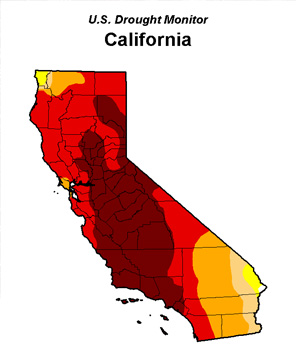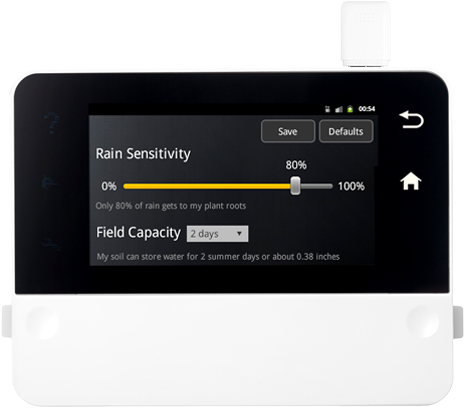✆ Call us | ✉ Email us Home / Blog archive - 2014
Drought Devices 2.0
Droughts cannot be avoided, but pain can be lessened.
Sep 14, 2014, by admin
 Fig 1, Drought in California,
Fig 1, Drought in California,source United States Drought monitor.
Droughts are climatic events of gigantic proportions and unfortunately, California is currently experiencing one of the most severe droughts in recorded history. Predicting the length of a drought is difficult and often times predictions end in disappointment.
Don't kill that lawn just yet.
Hydrate at maximum efficiency.
An irrigation controller, in essence, is a local drought fighter device. It helps irrigate your lawn, keeping it green and healthy, even during dry spells. Unlike the RainMachine, a traditional irrigation controller is unaware of the climate surrounding it, dispensing the same amount of water day after day, year after year. By using the RainMachine your home just become smarter: during cold periods (droughts have cold periods too), the RainMachine lowers the amount of used water according to temperature. The savings become more apparent during spring, autumn and wintertime.
Follow the Green.
City Regulations and substantial dollar savings.
Often times during a drought, local communities force users to conserve water by imposing watering schedules. The RainMachine is perfect for complex watering schedules such as “water every number of days", or water restrictions on predetermined days. Despite complicated watering schedules, the RainMachine is able to calculate the required amount of water required by evapotranspiration for up to 7 days.
Join the Conservation Revolution.
California leading the pack.
Because of the persistent drought in California, we saw a strong demand in smart irrigation devices. Unfortunately, we cannot fix the drought, but we can help you adapt. Join the water conservation movement! Because we believe in our idea, our open source software is available on all devices. Use it, share it and improve it. The water belongs to us.
Huge Water Savings.
MegaDroughts, MegaSolutions.
 Fig 2, RainMachines in Sillicon Valley. © Google Maps
Fig 2, RainMachines in Sillicon Valley. © Google Maps
Over the past year, using thousands of RainMachines in California we calculated that the total amount of water saved can measure in Olympic size swimming pools and MegaW/h of energy required to pump the water. This is Enough power required to fully charge 10 million mobile phones or the equivalent of driving half million miles!
- sources:
- http://cetulare.ucanr.edu/files/82040.pdf
- http://www.clemson.edu/extension/hgic/plants/other/irrigation/hgic1802.html
- http://www.prescott-az.gov/_d/irrigation.pdf
- http://droughtmonitor.unl.edu/Home/StateDroughtMonitor.aspx?CA
- Which States Use the Most Water?
- 25 Ways to Conserve Water in the Home and Yard
- Ideas For Kids To Help With Conserving Water At Home
- Save Water at School
- 10 ways to save water in commercial buildings
- Financial Incentives for Green Home Improvements
- Saving Water While Traveling
